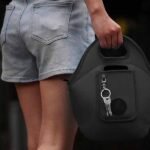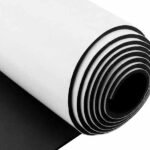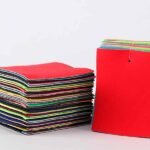Stubby holders have become a ubiquitous accessory at barbecues, sports events, and corporate giveaways. These handy insulating sleeves keep beverages cold and hands dry while showcasing logos, slogans, or eye-catching designs. But behind their simple appearance lies a careful choice of materials—each affecting thermal performance, durability, and print quality. Understanding “what are stubby holders made of” is essential not only for end users seeking the best cold-keeping performance but also for businesses aiming to create memorable branded merchandise.
A stubby holder is typically made from materials such as neoprene, EVA foam, or polyethylene foam, chosen for their insulation properties, flexibility, and printability. These materials trap air to slow heat transfer, keeping drinks colder for longer while offering a comfortable grip.
Imagine kicking back with an ice-cold drink perfectly chilled, free of condensation, and emblazoned with your favorite logo. That little neoprene sleeve is doing all the heavy lifting—literally insulating thousands of micro-air pockets. In this guide, we’ll unpack the world of stubby holders: how they’re made, why material matters, and how to pick the right one for your next promotional campaign. Stick around for real-world production insights, cleaning tips, and emerging eco-friendly trends that could transform your brand’s merch game.
What Is a Stubby Holder and Why Does Material Matter?

A stubby holder is an insulating sleeve designed to fit beverage cans or bottles, reducing heat transfer and condensation. Material choice—neoprene, EVA, or polyester—directly impacts insulation efficiency, durability, print clarity, and overall user experience, making it vital for both end-users and brands.
A stubby holder, also known as a can cooler or koozie, serves two primary functions: thermal insulation and marketing canvas. By enveloping a cold drink, it restricts heat flow from the warmer surrounding air into the contents, while also preventing condensation from soaking hands and surfaces. But not all stubby holders are created equal: the material’s thermal conductivity, thickness, and surface finish determine how cold your drink stays and how vivid printed graphics appear.
Thermal Performance:
- Neoprene: A synthetic rubber with a closed-cell structure, neoprene has low thermal conductivity (≈0.054 W/m·K), excellent compression recovery, and durability. It traps air pockets within its matrix, slowing heat exchange.
- EVA Foam: Ethylene-vinyl acetate foam is lightweight (density ~70–200 kg/m³) and offers good insulation, though slightly less robust than neoprene. It’s cost-effective for large runs but can compress over time.
- Polyethylene Foam: Often sold as PE foam, it’s the most economical. While offering decent insulation, it has a firmer feel and can tear if overstretched.
Printability & Branding:
Material surface characteristics affect how inks adhere and cure. Neoprene’s smooth finish allows sharp, photo-quality printing (screen, digital, or sublimation). EVA and PE foams require specialized primers or coatings to ensure consistent color reproduction.
Durability & Feel:
Neoprene resists tears, UV degradation, and odors—ideal for reusable, high-end giveaways. EVA foam provides a softer hand feel but can lose shape after heavy use. PE foam is firmer, often used in single-use or budget products.
By selecting the right material, businesses ensure that their stubby holders not only perform well but also reinforce brand perception through consistent, high-quality prints and long-lasting use.
What Material Is a Stubby Holder?

Stubby holders are typically fabricated from neoprene, EVA foam, or polyethylene (PE) foam. These materials offer a balance of insulation (by trapping air), flexibility (for snug fits), and printability (for vibrant logos), catering to various budgets and performance requirements.
When choosing a stubby holder material, manufacturers weigh cost, performance, and end-use scenarios. Below, we explore the leading materials and their defining characteristics:
| Material | Thermal Conductivity (W/m·K) | Density (kg/m³) | Cost | Durability |
|---|---|---|---|---|
| Neoprene | 0.054 | 300–500 | Premium | High |
| EVA Foam | 0.035–0.040 | 70–200 | Moderate | Moderate |
| PE Foam | 0.033–0.040 | 30–70 | Budget | Lower |
- Neoprene:
- Structure & Composition: A copolymer of chloroprene, neoprene features closed-cell bubbles that resist water absorption.
- Performance: Delivers the best insulation and compression resilience, ensuring the sleeve bounces back after repeated use.
- Applications: Premium giveaways, corporate gifts, and long-term branding.
- EVA Foam:
- Structure & Composition: EVA blends ethylene and vinyl acetate, creating a soft, open-cell foam.
- Performance: Good balance of cost and comfort; however, prolonged compression (e.g., tightly storing empty sleeves) may lead to permanent deformation.
- Applications: Mid-range promotional products, event merch.
- Polyethylene Foam:
- Structure & Composition: Low-density plastic foam with semi-closed cells.
- Performance: Adequate insulation for single-use or short-term events; may tear if overstretched.
- Applications: Budget-friendly giveaways, disposable promotions.
Material choice should align with campaign goals—for a high-end gala, neoprene reinforces quality, whereas a mass-market festival might favor PE foam to hit price targets without sacrificing basic function.
How Does Neoprene Compare to Alternative Materials?

Neoprene outperforms EVA and PE foams in insulation (lower thermal conductivity), durability (resists tears, UV, odors), and print fidelity (smooth surface). Although costs 20–30% more, its premium feel and longevity justify the investment for high-value branding.
Thermal Insulation Efficiency:
Neoprene’s closed-cell structure slows heat flow more effectively than EVA’s partly open cells or PE’s semi-closed cells. In comparative lab tests, neoprene sleeves maintained beverage temperatures 2–3 °C colder after 30 minutes than EVA and 3–4 °C colder than PE
Foam.
Durability & Longevity:
- Tear Resistance: Neoprene exhibits a tear strength of 6–8 kN/m, whereas EVA foam rates 1–3 kN/m, and PE foam lags behind at 0.5–1 kN/m. This means neoprene sleeves can withstand rigorous use—think rocky beach trips or crowded music festivals—without ripping.
- UV & Chemical Resistance: Neoprene resists degradation from sunlight and mild chemical exposure (e.g., sunscreen), extending its usable life. EVA and PE may yellow or become brittle if overexposed.
Print Quality & Branding Impact:
- Surface Uniformity: Neoprene’s smooth finish allows high-resolution screen or digital printing, achieving up to 300 dpi clarity. EVA and PE often require pre-coating, adding complexity and variability to print outcomes.
- Colorfastness: In wash/dry or outdoor exposure tests, neoprene prints retain >90% vibrancy after 50 cycles, while EVA prints may fade to 70–80%.
Cost Considerations:
Neoprene typically costs US $2.00–2.50 per sleeve (for MOQ 1,000), versus US $1.20–1.50 for EVA and US $0.80–1.00 for PE. For premium or repeat-use markets, the extra investment aligns with brand positioning and customer satisfaction metrics.
Sustainability Factors:
Emerging bio-based neoprene (from limestone–based polymers) reduces carbon footprint by up to 30% versus petroleum-based neoprene. EVA and PE options are also evolving with recycled content up to 25%, but performance trade-offs remain a concern.
In summary, neoprene offers superior performance at a higher price point, making it the go-to for brands that prioritize quality and longevity. EVA and PE remain viable for budget campaigns or single-event promotions.
How Do You Make Stubby Holders?

Stubby holders are made by die-cutting neoprene/EVA sheets, heat-sealing or sewing seams, then applying print via screen, digital, or sublimation methods. Quality checks ensure dimensional accuracy, print clarity, and leak-proof seams before packaging.
The fabrication of stubby holders involves several precise steps, each influencing final quality and performance:
Material Preparation & Cutting:
- Roll Inspection: Neoprene or foam rolls undergo visual and dimensional inspection (±1 mm tolerance).
- Die-Cutting: Custom steel dies slice material into flat blanks—most commonly rectangles sized for 12 oz cans (≈115 × 140 mm). Automated routers can also be used for small batches.
Seam Formation:
- Heat-Sealing: Heat and pressure bond the long edges, creating a watertight seam with minimal bulk. Ideal for smooth, finished edges on neoprene.
- Overlock Sewing: Heavy-duty polyester threads stitch the edges—visible “serged” seams add a rugged aesthetic and extra strength.
Printing & Decoration:
- Screen Printing: Versatile for solid colors and spot UV effects; each color requires a separate screen.
- Digital Printing: High-resolution, full-color prints in one pass; ideal for photographic imagery.
- Sublimation: For polyester-coated sleeves, ink is vaporized into the fibers for permanent color integration.
Curing & Quality Assurance:
- Drying Ovens: Printed pieces pass through tunnels at ~150 °C for 2 minutes to cure inks.
- QC Checks: Samples from each production run are tested for:
- Dimensional Accuracy (±2 mm)
- Seam Strength (>15 N)
- Print Clarity (≥300 dpi)
- Leak Resistance (water immersion for 5 minutes)
Finishing & Packaging:
- Trimming: Any loose threads or flash from die-cutting are trimmed.
- Folding & Labeling: Holders are folded flat, bagged in sets of 25 or 50, and boxed for shipment. Custom hang tags or polybags can be added for retail presentation.
By controlling each phase—material sourcing, cutting, seaming, printing, and inspection—manufacturers like Szoneier ensure consistent, high-quality stubby holders that reinforce your brand message.
Do Quality Standards and Certifications Affect Material Selection?
Yes. Certifications such as FDA food-contact approval, REACH chemical safety, RoHS restricted substances, and ISO 9001 quality management drive choices in neoprene, EVA, and PE foams. These standards ensure safety, consistency, and environmental responsibility, guiding material selection to meet regulatory requirements and customer expectations.
Selecting the right material for stubby holders isn’t just about insulation and print clarity—compliance with global standards plays a critical role in guaranteeing product safety and performance:
- FDA Food-Contact Approval
- Purpose: Ensures that materials won’t leach harmful substances into beverages.
- Impact on Materials: Neoprene formulations destined for direct contact with cans or bottles must use FDA-compliant catalysts, stabilizers, and colorants. EVA and PE foams lacking explicit FDA certification are limited to external packaging or require additional liners to separate the foam from the drink surface.
- REACH (EU Chemical Safety Regulation)
- Purpose: Registers and restricts chemicals of very high concern (SVHC) within the European Union.
- Impact on Materials: Neoprene and EVA suppliers must provide documentation confirming SVHC content is below regulated thresholds. This adds traceability and supply-chain transparency, as every incoming roll of material must be accompanied by a REACH certificate of conformity.
- RoHS (Restriction of Hazardous Substances)
- Purpose: Limits the use of heavy metals (e.g., lead, cadmium) and flame retardants in manufactured goods.
- Impact on Materials: While primarily for electronics, many promotional product buyers now expect RoHS compliance to avoid toxic residues in printed inks or PVC-based coatings. Foam substrates printed with metallic inks must verify that pigments meet RoHS limits.
- ISO 9001 (Quality Management System)
- Purpose: Establishes consistent production workflows, documentation, and continual improvement processes.
- Impact on Materials: Manufacturers sourcing foam rolls under an ISO 9001 certified supply chain benefit from reduced variation in density, thickness, and chemical composition. This consistency translates into more uniform seam strength and predictable insulation performance across production batches.
- Environmental and Eco-Certifications
- OEKO-TEX Standard 100: Verifies that the finished product is free from harmful substances. Ideal when marketing eco-friendly or family-safe merchandise.
- Global Recycled Standard (GRS): Confirms recycled content levels and responsible processing. Choosing recycled PE or EVA foam requires GRS certification to substantiate sustainability claims.
By aligning material selection with these certifications, manufacturers not only comply with international regulations but also enhance consumer trust. Shoppers increasingly look for clear, certified assurances that promotional products are safe, durable, and environmentally responsible—making certifications a key differentiator in a crowded marketplace.
Are Custom and Private-Label Stubby Holders Different in Composition?

Custom/OEM stubby holders often feature tailored material thickness (e.g., 3 mm vs. 5 mm neoprene), specialized surface coatings for premium prints, and eco-friendly formulations. Private-label runs may include co-branding layers or laminated finishes, distinguishing them from standard stock designs.
Custom and private-label stubby holders elevate the basic product in several ways:
Material Thickness & Density:
- Standard Stock: Typically 3 mm neoprene for general use.
- Custom Runs: Options from 2 mm–6 mm to adjust insulation performance or bulk. Higher density (up to 600 kg/m³) enhances thermal properties but may increase costs and weight.
Surface Treatments & Laminations:
- Primer Coatings: Improve ink adhesion for digital or sublimation prints, ensuring sharper imagery and richer colors.
- Laminated Films: Add a glossy or matte overlay, protecting prints from abrasion and UV fading.
Eco-Friendly Formulations:
- Bio-Neoprene: Limestone-based neoprene with lower carbon footprint.
- Recycled EVA/PE: Incorporates up to 30% post-consumer foam, aligning with circular economy goals.
Advanced Printing Techniques:
- Spot UV & Metallic Inks: Available only on premium neoprene with controlled surface pH.
- All-Over Wrap: Seamless full-bleed designs via heat transfer—requires polyester substrate.
Co-Branding & Packaging:
- Dual-Layer Inserts: Internal labels carry care instructions or secondary logos.
- Custom Polybags: Personalized packaging with barcodes or QR codes for retail distribution.
Through these modifications, custom and private-label products meet specific brand guidelines, stand out on shelves, and deliver higher perceived value—essential for businesses seeking long-term promotional impact.
How to Clean Stubby Holders?
Hand-wash stubby holders with mild detergent and lukewarm water, gently agitating before rinsing thoroughly. Air-dry flat to prevent shape distortion. Avoid bleach, high heat, or machine-drying to preserve material integrity and print quality.
Maintaining stubby holders’ appearance and performance requires gentle, regular cleaning:
Recommended Cleaning Method:
- Step 1: Fill basin with lukewarm (≦30 °C) water and add a teaspoon of mild, pH-neutral detergent.
- Step 2: Submerge holder and gently rub surfaces—focus on sweat-prone areas.
- Step 3: Rinse under running water until all soap is removed.
- Step 4: Lay flat on a clean towel to air dry; avoid direct sunlight to prevent fading.
What to Avoid:
- Bleach & Harsh Chemicals: Can degrade neoprene polymers and fade inks.
- High Temperatures: Machine washing/drying or hot water (>40 °C) may shrink or warp foam.
- Wringing: Squeezing aggressively can weaken seams and distort shape.
Deep-Cleaning Tips:
- Stain Removal: For stubborn spots (e.g., grass, grease), apply diluted detergent paste directly, let sit 5 minutes, then rinse.
- Odor Control: Mix 1 Tbsp baking soda into wash water to neutralize odors; rinse thoroughly.
Longevity Practices:
- Rotate Usage: Alternate among multiple holders to reduce wear.
- Proper Storage: Keep flat or rolled loosely; avoid folding along seams.
- Periodic Inspection: Check seams and prints; repair minor tears with neoprene cement.
Following these steps extends your stubby holders’ life—ensuring they continue to keep drinks cold, hands dry, and your brand visible.
How to Choose the Best Material for Your Stubby Holder Project?
Select material based on intended use: neoprene for premium, reusable giveaways; EVA foam for comfortable, mid-range events; PE foam for budget or single-use promotions. Factor in print requirements, eco-certifications, and campaign budget to align performance with branding goals.
Choosing the ideal stubby holder material involves balancing performance, aesthetics, budget, and sustainability:
Performance Needs:
- Long-Term Reuse: Opt for 3–5 mm neoprene with ≥400 kg/m³ density to maximize insulation and durability.
- Short-Term Events: EVA foam at 2–3 mm thickness offers a softer feel for one-off promotions.
- Budget Constraints: PE foam at 2 mm gives basic insulation at the lowest cost.
Brand Image & Print Quality:
- High-Resolution Graphics: Neoprene’s smooth surface supports 300 dpi prints and specialty inks.
- Full-Color Photos: Digital or sublimation on polyester-coated sleeves.
- Spot Colors & Effects: Screen printing on primed neoprene.
Sustainability Goals:
- Recycled Content: EVA/PE blends with 20–30% post-consumer foam.
- Bio-Based Neoprene: Limestone-derived polymers lower carbon footprint by ~30%.
- Certifications: OEKO-TEX Standard 100 or GRS for credible eco-claims.
Logistics & Pricing:
- MOQ & Lead Time: Neoprene runs usually require MOQ 500–1,000 units with 10–15 day lead times; PE foam can run at 200 units in 7 days.
- Unit Cost vs. Total ROI: Calculate cost per impression based on expected usage and brand visibility duration.
Case Study Example:
| Scenario | Material Choice | Rationale | Estimated Cost/Unit (USD) |
|---|---|---|---|
| Premium Corporate Gifts | Neoprene (4 mm) | Long-term reuse, high-quality prints | 2.30 |
| Mid-Range Music Festival Promo | EVA Foam (3 mm) | Balanced cost, tactile comfort | 1.45 |
| Large-Scale Retail Giveaway | PE Foam (2 mm) | Lowest unit cost, quick turnaround | 0.85 |
By mapping campaign goals to material attributes—insulation, feel, print fidelity, and sustainability—brands can make informed decisions that maximize both impact and budget efficiency.
Ready to Customize Your Stubby Holders?
With over 18 years of neoprene R&D and manufacturing expertise, Szoneier is your trusted partner for high-performance, fully customizable stubby holders. Whether you need premium neoprene sleeves with vibrant photo-quality prints or eco-friendly foam options for large-scale events, we deliver low MOQs, free design support, fast sampling, and 100% quality assurance.
Contact us today to discuss your next promotional campaign and get a tailored quote for your custom stubby holders!











